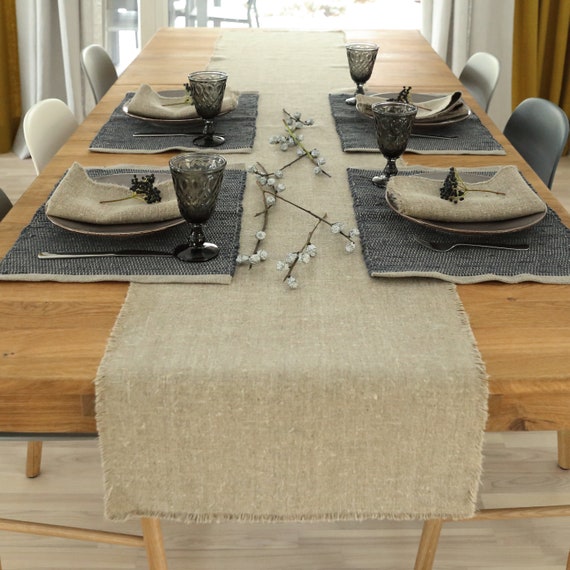Imaginative Table Runner Uses: Beyond the Dining Table
Wiki Article
Linen Textile Developments: Checking Out Modern Trends and Creative Applications in Layout and Fabric Industry
From sustainable production methods to cutting-edge weaving modern technologies, the advancement of bed linen is improving the landscape of the fabric market. As we delve into the worlds of imaginative style applications and the development of linen blends and crossbreed textiles, a brand-new chapter unravels in which bed linen's function in future textile innovations takes center stage.Lasting Practices in Bed Linen Manufacturing
Sustainable practices in bed linen production have come to be increasingly crucial in the fabric sector's efforts to minimize ecological impact and advertise honest sourcing techniques. Linen, an all-natural fiber obtained from the flax plant, offers a variety of advantages such as breathability, sturdiness, and biodegradability. Nonetheless, standard approaches of linen manufacturing can include significant water usage, chemical use, and energy-intensive procedures.To attend to these challenges, lots of fabric makers are taking on sustainable techniques throughout the linen production procedure. This includes sourcing flax from natural farms that prevent unsafe pesticides and chemicals, executing water-efficient retting strategies to remove fibers from the flax stalks, and making use of environmentally friendly dyes and surfaces. Furthermore, some companies are purchasing sustainable power resources to power their production centers and reducing waste through recycling and upcycling efforts.
Technological Improvements in Bed Linen Weaving
With the expanding emphasis on sustainable practices in linen manufacturing, the fabric industry is now seeing a surge in technical innovations especially targeted at transforming the art of linen weaving. These advancements are improving the way linen materials are created, using raised effectiveness, top quality, and creativity in weaving techniques.One of the vital technical advancements in linen weaving is the integration of electronic looms. These sophisticated looms are equipped with software that enables complicated and complex styles to be woven with precision. By digitizing the weaving process, suppliers can attain higher consistency and accuracy in their bed linen textiles.
In addition, innovations in thread spinning innovation have made it possible for the manufacturing of finer and more resilient linen yarns - table cloths. This leads to softer and smoother linen materials that maintain their high quality even after numerous uses and laundries
Additionally, the development of environmentally friendly dyeing processes and finishes for bed linen textiles is acquiring traction. These sustainable practices not just lower the ecological impact but additionally deal with the boosting consumer demand for ethically created textiles.
Creative Design Applications for Bed Linen
Cutting-edge artistic techniques are increasingly forming the creative style applications for bed linen in the textile market. Bed linen's natural aesthetic charm and capacity to blend with various other fabrics make it a preferred selection for creating special garments and devices that cater to the ecologically aware consumer.Additionally, developers are explore linen in home design, utilizing its durable and breathable nature to craft elegant home furnishings such as curtains, bedding, and upholstery. The appearance and drape of linen bring a sense of class and convenience to interior spaces, adding a touch of beauty to contemporary homes.

Linen Blends and Hybrid Fabrics

Hybrid fabrics, on the other hand, take the concept of mixing an action better by including extra aspects such as metal strings, recycled materials, or conductive fibers. These innovative fabrics not only expand the layout possibilities but also present functional facets like conductivity, antimicrobial residential properties, or improved sturdiness. Hybrid textiles are significantly being used in different markets, including style, interior decoration, and technical fabrics, where the need for multifunctional products is on the surge.
Linen's Function in Future Fabric Innovations
:max_bytes(150000):strip_icc()/smooth-linen-tableware-sky-24_2000x-e91a79aab4354001b5445ec12d511141.jpg)
In the world of future textile technologies, bed linen is expected to be a key player in the advancement of sophisticated useful materials. Designers and researchers are checking out methods to enhance linen's inherent qualities through technical developments, such as including smart textiles, nanotechnology, and performance surfaces. These innovations intend to boost bed linen's performance characteristics, making it appropriate for a wider range of applications, from activewear to protective clothing.
Moreover, the mix of linen with various other all-natural or synthetic fibers opens unlimited possibilities for developing unique textiles with distinct homes and performances. By leveraging linen's characteristics and exploring cutting-edge blends, the fabric market is positioned to present exciting advancements that provide to advancing customer requirements and sustainability requirements.
Verdict
Finally, the exploration of lasting methods, technological innovations, imaginative style applications, linen blends, and check my site its duty in future fabric developments highlight the continuous advancement of linen textile in the YOURURL.com contemporary layout and textile industry. With an emphasis on innovation and creative thinking, the adaptability and eco-friendly nature of bed linen make it a valuable material for producers and developers alike, paving the way for further developments and advancements in the area of textiles.As we dig right into the realms of imaginative design applications and the introduction of bed linen blends and crossbreed fabrics, a brand-new chapter unfolds in which linen's function in future textile developments takes center stage.
Exploring the blend of bed linen with various other materials has led to the emergence of cutting-edge blends and hybrid fabrics in the contemporary textile sector. Bed linen blends use an one-of-a-kind combination of the qualities of bed linen with those of various other fibers, resulting in fabrics that possess improved properties such as enhanced longevity, boosted draping, and lowered wrinkling.The development of linen blends and crossbreed materials has set the stage for Bed linen to play a critical role in driving future fabric advancements.In the realm of future fabric developments, linen is expected to be an essential gamer in the development of innovative practical materials.
Report this wiki page